
Apiaceae or Umbelliferae is a family of mostly aromatic flowering plants named after the type genus Apium, and commonly known as the celery, carrot or parsley family, or simply as umbellifers. It is the 16th-largest family of flowering plants, with more than 3,800 species in about 446 genera, including such well-known, and economically important plants as ajwain, angelica, anise, asafoetida, caraway, carrot, celery, chervil, coriander, cumin, dill, fennel, lovage, cow parsley, parsley, parsnip and sea holly, as well as silphium, a plant whose exact identity is unclear and it may be extinct.
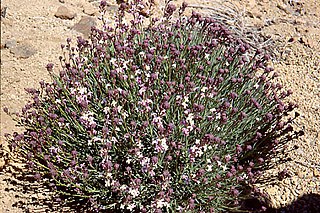
Erysimum, or wallflower, is a genus of flowering plants in the cabbage family, Brassicaceae. It includes more than 150 species, both popular garden plants and many wild forms. Erysimum is characterised by star-shaped and/or two-sided) trichomes growing from the stem, with yellow, red, pink or orange flowers and multiseeded seed pods.
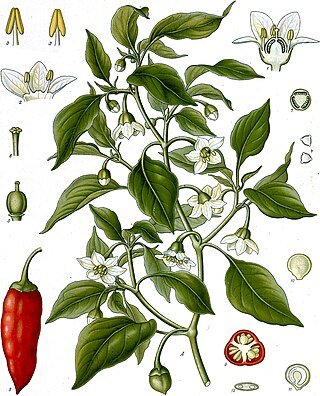
Capsicum annuum is a fruiting plant from the family Solanaceae (nightshades), within the genus Capsicum which is native to the northern regions of South America and to southwestern North America. The plant produces berries of many colors including red, green, and yellow, often with pungent taste. It also has many varieties and common names including paprika, chili pepper, jalapeño, cayenne, bell pepper, and many more with over 200 variations within the species. It is also one of the oldest cultivated crops, with domestication dating back to around 6,000 years ago in regions of Mexico. The genus Capsicum has over 30 species but Capsicum annuum is the primary species in its genus, as it has been widely cultivated for human consumption for a substantial amount of time and has spread across the world. This species has many uses in culinary applications, medicine, self defense, and can even be ornamental.

In spermatophyte plants, seed dispersal is the movement, spread or transport of seeds away from the parent plant. Plants have limited mobility and rely upon a variety of dispersal vectors to transport their seeds, including both abiotic vectors, such as the wind, and living (biotic) vectors such as birds. Seeds can be dispersed away from the parent plant individually or collectively, as well as dispersed in both space and time. The patterns of seed dispersal are determined in large part by the dispersal mechanism and this has important implications for the demographic and genetic structure of plant populations, as well as migration patterns and species interactions. There are five main modes of seed dispersal: gravity, wind, ballistic, water, and by animals. Some plants are serotinous and only disperse their seeds in response to an environmental stimulus. These modes are typically inferred based on adaptations, such as wings or fleshy fruit. However, this simplified view may ignore complexity in dispersal. Plants can disperse via modes without possessing the typical associated adaptations and plant traits may be multifunctional.
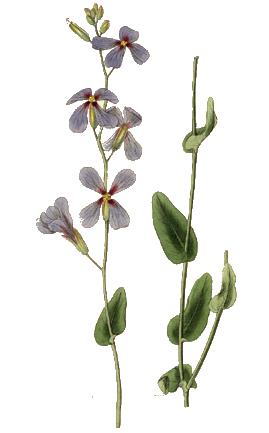
Moricandia is a genus of plants of the family Brassicaceae. This genus is mainly distributed in North Africa, the Middle East, and Southern Europe. It is associated with arid and semi-arid environments. Flowers of this genus are actinomorphic-dissymmetrical and mostly lilac in color, although they vary from white to purple depending on the species and climatic conditions. Some species show extreme phenotypic plasticity for flower size, shape, and color. The fruits are two-valved dehiscent siliques with one or two sets of seeds per valve.

Clianthus puniceus, common name kaka beak, is a species of flowering plant in the genus Clianthus of the legume family Fabaceae, native to New Zealand's North Island.

Erysimum nevadense is a perennial short-lived herb endemic to the Sierra Nevada of Spain, although there are some citations in the nearby Sierra de Gádor (Almería). This wallflower occurs between 1,700 and 2,700 m above sea level in subalpine scrublands and alpine meadows. It may be treated as a narrowly circumscribed single species, one of a group or complex of six separate species, or as a more broadly circumscribed species with six subspecies.
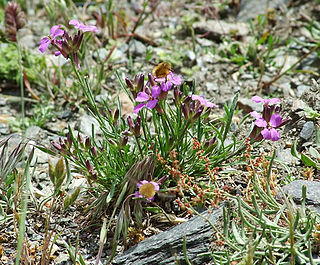
Erysimum baeticum is an annual to perennial herb endemic to some mountains in the SE of Spain. This species has two subspecies: Erysimum baeticum bastetanum is found only in the Sierra de Baza, inhabiting the subalpine pine forests, from 1500 to 2000 m. a.s.l.. Erysimum baeticum baeticum is a subspecies endemic to the eastern range of the Sierra Nevada, inhabiting subalpine shrublands. Both subspecies flower during late May thru early July, displaying up to one hundred showy purple flowers arranged in several short stalks.
This page provides a glossary of plant morphology. Botanists and other biologists who study plant morphology use a number of different terms to classify and identify plant organs and parts that can be observed using no more than a handheld magnifying lens. This page provides help in understanding the numerous other pages describing plants by their various taxa. The accompanying page—Plant morphology—provides an overview of the science of the external form of plants. There is also an alphabetical list: Glossary of botanical terms. In contrast, this page deals with botanical terms in a systematic manner, with some illustrations, and organized by plant anatomy and function in plant physiology.
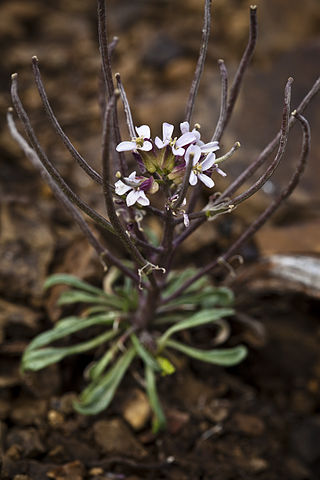
Erysimum redowskii, synonym Erysimum pallasii, known as Pallas' wallflower, is a low shrub or mid shrub species from the Arctic. It has purple flowers that do not reflect UV.

Persoonia lanceolata, commonly known as lance-leaf geebung, is a shrub native to New South Wales in eastern Australia. It reaches 3 m (10 ft) in height and has smooth grey bark and bright green foliage. Its small yellow flowers grow on racemes and appear in the austral summer and autumn, followed by green fleshy fruits which ripen the following spring. Within the genus Persoonia, P. lanceolata belongs to the lanceolata group of 58 closely related species. It interbreeds with several other species found in its range.
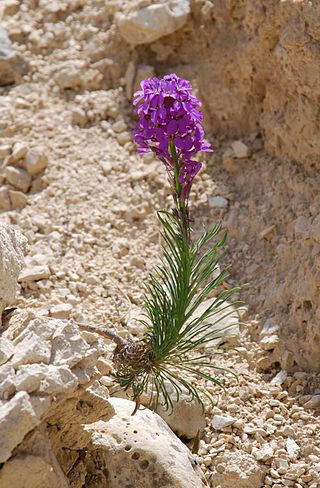
Erysimum cazorlense is a short-lived, mostly monocarpic herb endemic to the Cazorla and Segura mountain ranges, SE Spain. Erysimum cazorlense may be treated as a distinct species or as Erysimum myriophyllum subsp. cazorlense.

Pyrus bourgaeana, the Iberian pear, is a close relative of Pyrus communis L. The latter was domesticated about 2500 years ago. This small tree is widely distributed across the southern Iberian Peninsula and northern Morocco, where it coexists with four Pyrus species: P. communis L., P. cordata Dew., P. spinosa Forssk, and P. nivalis Jacq. Characteristics to discriminate these species are the width of fruit peduncle, petal size, leaf width and petiole length served to the taxa.

Erysimum collinum is a plant species in the family Brassicaceae. It is a member of the genus Erysimum, which includes between 150 and 350 species in the Northern Hemisphere.
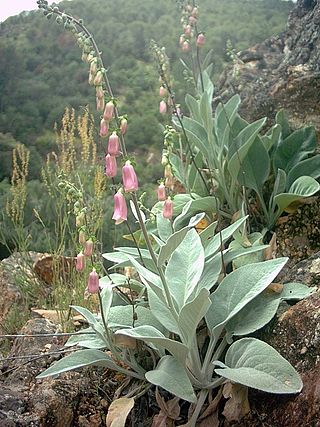
Digitalis mariana is a flowering plant species in the family Plantaginaceae. It is a perennial foxglove with evergreen foliage and rose-red flowers, which are produced in summer. It is native to Portugal and Spain.
Erysimum fitzii is a biennial or short-lived perennial plant native to southern Spain. It has been treated as one of a complex of six species making up the nevadense group, or as Erysimum nevadense subsp. fitzii.
Erysimum gomez-campoi is a short-lived biennial or perennial plant native to southern Spain. It has been treated as one of a complex of six species making up the nevadense group, or as Erysimum nevadense subsp. gomez-campoi.
Erysimum merxmuelleri is a biennial or short-lived perennial plant native from eastern Portugal to western Spain. It has been treated as one of a complex of six species making up the nevadense group, or as Erysimum nevadense subsp. merxmuelleri.
Erysimum rondae is a biennial or short-lived perennial plant native to southwestern Spain. It has been treated as one of a complex of six species making up the nevadense group, or as Erysimum nevadense subsp. rondae.














